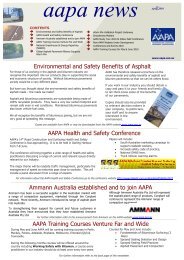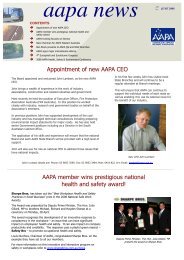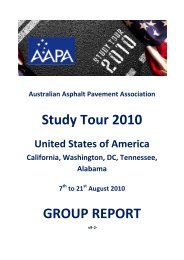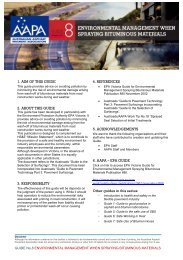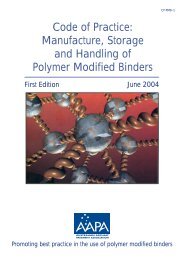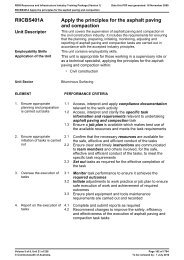Early Experience with the Use of Warm Mix Asphalt Technology in ...
Early Experience with the Use of Warm Mix Asphalt Technology in ...
Early Experience with the Use of Warm Mix Asphalt Technology in ...
You also want an ePaper? Increase the reach of your titles
YUMPU automatically turns print PDFs into web optimized ePapers that Google loves.
For both <strong>the</strong> Aspha-m<strong>in</strong>® zeolite and Sasobit wax methods, <strong>the</strong> situation isdifferent. For example, <strong>the</strong> National Center for <strong>Asphalt</strong> <strong>Technology</strong> (NCAT) <strong>in</strong> <strong>the</strong>USA conducted laboratory studies on both <strong>the</strong> Aspha-m<strong>in</strong>® zeolite and Sasobitwax methods and reported <strong>the</strong>m <strong>in</strong> 2005 [6,7]. Ano<strong>the</strong>r report on <strong>the</strong> performanceevaluation on mixes conta<strong>in</strong><strong>in</strong>g Sasobit has been done for <strong>the</strong> Maryland StateHighway Adm<strong>in</strong>istration.3. EvolutionThe concept <strong>of</strong> lower<strong>in</strong>g <strong>the</strong> heat used to produce asphalt mixes is not someth<strong>in</strong>g new.The idea <strong>of</strong> sav<strong>in</strong>g energy and lower<strong>in</strong>g emissions <strong>in</strong> <strong>the</strong> asphalt <strong>in</strong>dustry has beendiscussed for decades.It is known that as asphalt temperature decreases, its b<strong>in</strong>der becomes more viscousand resistant to deformation, which results <strong>in</strong> a smaller reduction <strong>in</strong> air voids for agiven compactive effort. Eventually, <strong>the</strong> b<strong>in</strong>der becomes stiff enough to prevent anyfur<strong>the</strong>r reduction <strong>in</strong> air voids regardless <strong>of</strong> <strong>the</strong> applied compactive effort. Thetemperature at which this occurs is known as <strong>the</strong> “cessation temperature” which isestimated to be about 79°C for dense graded asphalt. High temperatures for hot mixasphalt are required to achieve <strong>the</strong> right balance between:• Low viscosity <strong>of</strong> <strong>the</strong> bitumen to obta<strong>in</strong> full aggregate coat<strong>in</strong>g;• good workability dur<strong>in</strong>g lay<strong>in</strong>g and compaction;• rapid <strong>in</strong>crease <strong>in</strong> mechanical strength, and;• durability dur<strong>in</strong>g traffic exposure.<strong>Warm</strong> mix technology allows <strong>the</strong> temperatures <strong>of</strong> <strong>the</strong> HMA to be reduced dur<strong>in</strong>gmanufactur<strong>in</strong>g and still achieve all <strong>of</strong> <strong>the</strong> above. Effectively this is carried out by <strong>the</strong>reduction <strong>of</strong> <strong>the</strong> viscosity <strong>of</strong> <strong>the</strong> asphalt via <strong>the</strong> foam<strong>in</strong>g process <strong>of</strong> <strong>the</strong> b<strong>in</strong>der or by<strong>the</strong> physical viscosity reduction <strong>of</strong> <strong>the</strong> asphalt by <strong>the</strong> <strong>in</strong>corporation <strong>of</strong> wax additives.Amongst all <strong>of</strong> <strong>the</strong> technologies capable <strong>of</strong> achiev<strong>in</strong>g this, wax additives and <strong>the</strong>Zeolite technologies were found to be <strong>the</strong> most practical for evaluation and trialpurposes <strong>in</strong> Australia. In addition to <strong>the</strong> lower<strong>in</strong>g <strong>of</strong> asphalt manufactur<strong>in</strong>gtemperatures <strong>the</strong> wax additives also, allow asphalt to be carted over long distancesand <strong>the</strong>n laid whilst still achiev<strong>in</strong>g all <strong>of</strong> <strong>the</strong> relevant specification parameters. On thisbasis, Sasobit was chosen as <strong>the</strong> additive for <strong>the</strong>se trials.Sasobit is a product <strong>of</strong> Sasol Wax International and has been marketed <strong>in</strong> SouthAfrica, Europe, <strong>the</strong> USA and Asia s<strong>in</strong>ce 1997. Sasobit is a mixture <strong>of</strong> long cha<strong>in</strong>hydrocarbons produced from coal gasification or <strong>the</strong> conversion <strong>of</strong> natural gas us<strong>in</strong>g<strong>the</strong> Fischer-Tropsch syn<strong>the</strong>sis process. A product is produced that is highly crystall<strong>in</strong>e<strong>in</strong> structure, giv<strong>in</strong>g a very hard material (due to its solid condition) <strong>in</strong> relation tobitumen, but it is also very easily melted giv<strong>in</strong>g it a very low viscosity. It is this lowviscosity that allows asphalt to be manufactured at lower temperatures and still becompacted.3
5. Case Studiesa) Deep Heavy Patch<strong>in</strong>g (Woodville Road, Sydney NSW) – 1.5% Sasobitadded.This trial served to demonstrate <strong>the</strong> benefits <strong>of</strong> warm mix asphalt technology whenconstruction timeframe is critically tight.The job comprised <strong>of</strong> full pavement reconstruction <strong>in</strong>volv<strong>in</strong>g mill<strong>in</strong>g 410mm <strong>of</strong>exist<strong>in</strong>g pavement, plac<strong>in</strong>g 200mm <strong>of</strong> stabilised dense graded roadbase and 210mm <strong>of</strong>asphalt <strong>in</strong> four layers (two layers <strong>of</strong> 60mm <strong>of</strong> AC20 and two layers <strong>of</strong> AC14 <strong>with</strong>AR450 b<strong>in</strong>der).The asphalt was mixed at 130 °C (<strong>the</strong> lowest temperature that would allow <strong>the</strong>bitumen to be pumped efficiently). Lower temperatures may not be recommended <strong>in</strong>cases <strong>in</strong> which <strong>the</strong> aggregates show relatively high moisture contents.The ma<strong>in</strong> risk <strong>in</strong> this job was rutt<strong>in</strong>g as a consequence <strong>of</strong> low stability due to reta<strong>in</strong>edheat <strong>in</strong> <strong>the</strong> underly<strong>in</strong>g layers. Conventional hot mix asphalt is usually overlaid when<strong>the</strong> surface temperature is below <strong>the</strong> s<strong>of</strong>ten<strong>in</strong>g po<strong>in</strong>t <strong>of</strong> <strong>the</strong> b<strong>in</strong>der. In this case, <strong>the</strong>target was to overlay each layer when <strong>the</strong> surface temperature was around 50 °C orlower. Road Occupancy approval to carry out asphalt work was given from 8pm to5am. The effective timeframe is reduced by approximately 1 hour due to allow trafficcontrol set up and removal.140130120110Temperature (°C)10090807060Probe-1aProbe-2aProbe-2bProbe-3aProbe-3bProbe-4a50400 50 100 150 200 250 300Time (m<strong>in</strong>utes)Figure 3 – Temperature pr<strong>of</strong>iles6
H11*>100.0°C100.090.080.070.066.060.050.040.030.020.080.675.085.060.277.888.464.6*
AC14DG + Sasobit ex Dubbo3.5Track<strong>in</strong>g Depth (mm)32.521.510.500 2000 4000 6000 8000 10000 12000PassesFigure 13 – Wheeltrack<strong>in</strong>g graphDiscussion: The asphalt was still able to be handworked and <strong>the</strong>re were m<strong>in</strong>imallosses due to cooled asphalt. Total asphalt losses were estimated to be 5% or less andmost <strong>of</strong> this was due to overrun on <strong>the</strong> ends <strong>of</strong> <strong>the</strong> area that was paved. Pav<strong>in</strong>g,<strong>in</strong>clud<strong>in</strong>g handwork, and compaction were carried out as normal <strong>with</strong> good results.Based on <strong>the</strong> success <strong>of</strong> this project, fur<strong>the</strong>r long haul projects us<strong>in</strong>g Sasobitmodified asphalt were carried out <strong>in</strong> NSW and <strong>in</strong> o<strong>the</strong>r states such as WesternAustralia and Queensland.d) Long Haul and Cold Wea<strong>the</strong>r Pav<strong>in</strong>g: Canberra to J<strong>in</strong>dabyne.<strong>Asphalt</strong> pav<strong>in</strong>g was required on <strong>the</strong> upgraded dam wall at J<strong>in</strong>dabyne. This work wasto be carried out <strong>in</strong> w<strong>in</strong>ter (August 06) and comprised two layers <strong>of</strong> AC10 at nom<strong>in</strong>althicknesses <strong>of</strong> 40mm and 35mm.The asphalt was produced at Boral <strong>Asphalt</strong>’s Canberra plant and hauled 200km southto <strong>the</strong> foot <strong>of</strong> <strong>the</strong> Australian Alps at J<strong>in</strong>dabyne. The travel time was 2.5 to 3 hours and<strong>the</strong> asphalt was produced at around 175 o C. To improve workability and to allow forcool wea<strong>the</strong>r pav<strong>in</strong>g, 1% Sasobit was pre-blended <strong>in</strong> Class 320 b<strong>in</strong>der.Ambient temperatures were around 4 o C <strong>with</strong> a pavement temperature <strong>of</strong> m<strong>in</strong>us 1 o C.<strong>Asphalt</strong> surface temperatures <strong>in</strong> <strong>the</strong> truck at J<strong>in</strong>dabyne ranged from 104 o C to 135 o C<strong>with</strong> truck core temperatures from 145 o C to 165 o C.16
Figure 14 - Pav<strong>in</strong>g <strong>of</strong> one layercompletedFigure 15 - AmbienttemperaturesDiscussion: Workability <strong>of</strong> <strong>the</strong> mix was reported as good and <strong>the</strong>re was m<strong>in</strong>imal loss<strong>of</strong> material due to cool<strong>in</strong>g <strong>of</strong> <strong>the</strong> mix. No slump<strong>in</strong>g <strong>of</strong> <strong>the</strong> mix was observed and <strong>the</strong>rewas m<strong>in</strong>imal stick<strong>in</strong>g <strong>of</strong> <strong>the</strong> asphalt to <strong>the</strong> truck sides and front as is normallyassociated <strong>with</strong> <strong>the</strong>se types <strong>of</strong> long haul projects. In spite <strong>of</strong> <strong>the</strong> long haul and pav<strong>in</strong>g<strong>in</strong> extremely cold conditions, <strong>the</strong> asphalt was placed and compacted successfully.6. Conclusions<strong>Warm</strong> asphalt mix technology, and <strong>in</strong> particular Sasobit, <strong>of</strong>fers a number <strong>of</strong>advantages as follows:• It allows for <strong>the</strong> construction <strong>of</strong> deep lift, multi layered asphalt heavy patch<strong>in</strong>gat lower temperatures. This consequently allows for earlier re-open<strong>in</strong>g <strong>of</strong> <strong>the</strong>road to traffic due to a reduction <strong>in</strong> reta<strong>in</strong>ed heat, which m<strong>in</strong>imises <strong>the</strong> risk <strong>of</strong>early life rutt<strong>in</strong>g.• Based on limited experience, <strong>the</strong> use <strong>of</strong> warm asphalt additives provides for amore homogeneous material and improved workability. Initial trials show thatpav<strong>in</strong>g and placement can be successfully carried out at ambient temperaturesthat are approach<strong>in</strong>g zero.• <strong>Warm</strong> asphalt additives, such as Sasobit, allow for reduced pav<strong>in</strong>g androll<strong>in</strong>g temperatures <strong>of</strong> up to 30 degrees C. This allows for greatly <strong>in</strong>creasedhaulage times and <strong>in</strong>itial trials show that asphalt can be placed successfullyafter haulage times <strong>of</strong> 10 hours or more.• Lower production temperatures represent a reduction <strong>in</strong> production energycosts.• In lower<strong>in</strong>g <strong>the</strong>se temperatures <strong>the</strong>re is a resultant reduction <strong>in</strong> fum<strong>in</strong>g andexposure to asphalt contam<strong>in</strong>ants. This has been successfully been applied tocrumb rubber asphalt mixes. Additional trials are be<strong>in</strong>g carried out <strong>in</strong> NewSouth Wales.17
7. References1. Kristjansdottir, O. <strong>Warm</strong> <strong>Mix</strong> <strong>Asphalt</strong> for Cold Wea<strong>the</strong>r Pav<strong>in</strong>g. Thesis <strong>in</strong>partial fulfilment for <strong>the</strong> degree <strong>of</strong> Master <strong>of</strong> Science <strong>in</strong> Civil Eng<strong>in</strong>eer<strong>in</strong>g,University <strong>of</strong> Wash<strong>in</strong>gton, 2006.2. Maccarrone, S. Cold asphalt systems as an alternative to hot mix. AAPAInternational Conference, November 1994.3. Jenk<strong>in</strong>s, K., De Groot, J., van de Ven, M. & Molenaar, A. Half-warmfoamed bitumen treatment, a new process. 7 th Conference on asphaltpavements for Sou<strong>the</strong>rn Africa (CAPSA), Victoria Falls, August-September 1999.4. Koenders, B., Stocker, D., Bowen, P., de Groot, P., Larsen, O., Hardy, D.& Wilms, K. Innovative processes <strong>in</strong> asphalt production and applicationto obta<strong>in</strong> lower operat<strong>in</strong>g temperatures. 2 nd Euroasphalt & EurobitumeCongress, Barcelona, Spa<strong>in</strong>. September 2000.5. Bar<strong>the</strong>l, W., Marchand, J., Von Devivere, M. <strong>Warm</strong> asphalt mixes byadd<strong>in</strong>g a syn<strong>the</strong>tic zeolite. Eurovia www.aspham<strong>in</strong>.com6. Hurley, G. & Prowell, B. Evaluation <strong>of</strong> Aspha-m<strong>in</strong> ® zeolite for use <strong>in</strong>warm mix asphalt. NCAT Report 05-06. National Center for <strong>Asphalt</strong><strong>Technology</strong>, Auburn University USA. June 2005.7. Hurley, G. & Prowell, B. Evaluation <strong>of</strong> Sasobit TM ® zeolite for use <strong>in</strong>warm mix asphalt. NCAT Report 05-06. National Center for <strong>Asphalt</strong><strong>Technology</strong>, Auburn University USA. June 2005.8. Bornmann, F., Strydom, S, Hiley, R. Fischer-Tropsch wax bitumenmodifier: Overcom<strong>in</strong>g temperature and time constra<strong>in</strong>ts. Sabita Digest2006. South African Bitumen Association, Cape Town, March 20079. RTA QA Specification RTA 3253 Bitumen for pavements. Edition 11.Approved 01 July 2006. Roads and Traffic Authority NSW.10. RTA QA Specification R116 <strong>Asphalt</strong> (Dense Grade And open Graded).RTA www.rta.nsw.gov.au18



